Moto G100 Review
Moto G100 Review
Are you Ready For this?
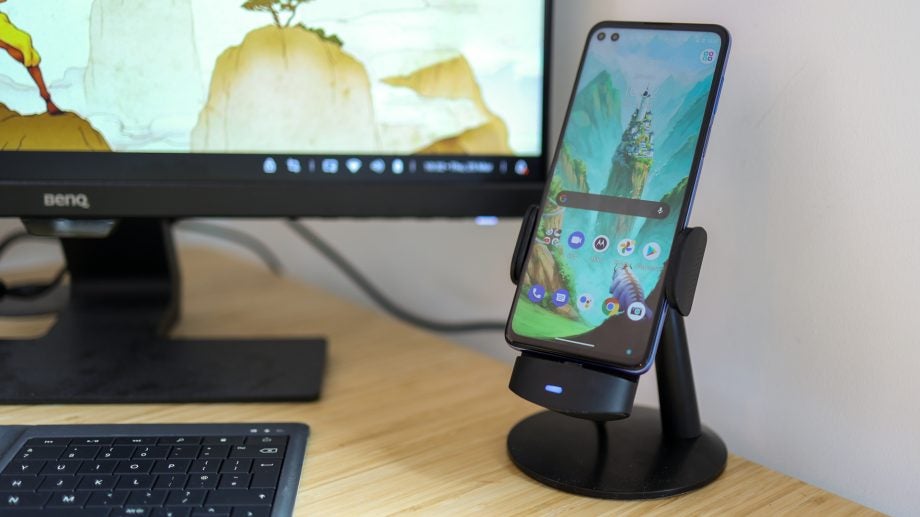
Verdict
You can’t argue with the value Motorola offers: the phone packs power and accessories at a reasonable price. Some risks have paid off, with the dock being a useful addition, albeit a clunky one. That said, with its hit and miss camera and an immature, chunky design it has fallen a bit flat.
Pros
- Powerful for the price
- Accessories included
- Clean Android interface
Cons
- Chunky design and very tall
- Immature design
- Underwhelming camera performance
Key Specifications
- Review Price: £449
- Snapdragon 870
- 90Hz display
- Ready For software
- Quad camera on the back
The £450/$500 price is the awkward middle child of smartphones, and that’s precisely where the Motorola Moto G100 sits — not quite budget or high-end.
On the one hand, the G100 heralds from a long line of affordable gems, with the original Moto Gs virtually defining the ‘budget smartphone that doesn’t fall to bits’ category. And in recent times, the Moto G8 and Moto G Pro have successfully built on the OG’s legacy.
With the Moto G100, Motorola’s doing something different in an effort to churn out the best Android phone. There are obvious wins out of the gate: it packs an almost flagship chipset, and ships with a fancy dock, which when hooked up to the phone and a TV or monitor, projects a new ‘Ready For’ UI to a big screen.
I do admire Motorola’s vision. The G100 is doing something different from the cookie-cutter cost-effective competition. That said, it costs more than other Moto Gs, so has a harder time justifying some Moto G traits.
Moto G100 pricing and release date
Motorola’s Moto G100 is being launched in Europe from a range of retailers, including Amazon and Motorola.com. No US availability has been announced at launch.
The phone is available in two colours, Iridescent Ocean and Iridescent Sky, though it is unclear whether there will be regional exclusivity for either colour.
Shipping with one RAM/storage combination in the UK — the can be picked up with 8GB RAM and 128GB storage, and ships with the dock and HDMI to USB-C cable for £449.99. The phone’s 20W wired charger is also in the box.
Motorola Moto G100 design and screen — A 90Hz holographic handful
- Heavily stylized plastic build
- Tall and chunky
- Ships with a case in box
Who’s the Moto G100 made for? Based on its design, unicorns and folks who don’t mind a bit of glisten and sparkle. The chunky plastic phone looks seriously fun on the one hand, changing colour as it grabs light from different angles — is it purple? Is it blue? Who knows.
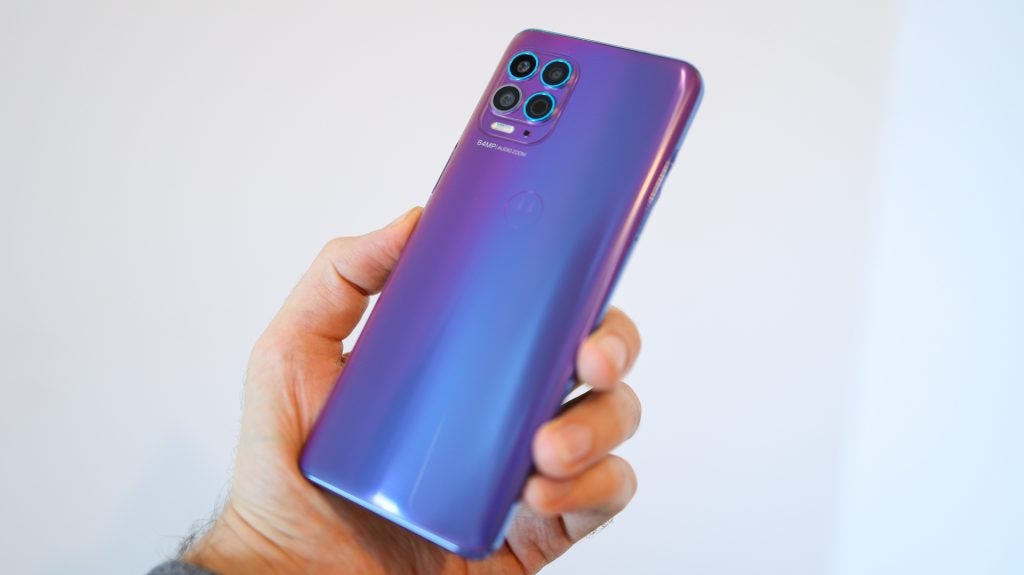
That said, it definitely doesn’t look or feel sleek. With a trademark Moto G-series chunk, it’s 9.7mm thick, exceptionally tall at 168.4mm (taller than a 163.3mm iPhone 12 Pro Max), and its matte, holographic plastic back screams 80s shellsuit fantasy.
Don’t get me wrong; I don’t hate fun, and I don’t have an issue with Moto G100 looking a bit zany. At the price though, between its heft and styling, I am just not entirely sure who the Moto G100 is made for.
Dotted around the phone, you’ll find a Google Assistant button to the left, a USB-C port and headphone port at the base, and on the right is a volume rocker, below which sits a fingerprint scanner/power button combo. Around the back, adorned by all that shimmery plastic is a stepped camera bump and a Motorola insignia.
The phone is curved on all sides, edges and corners, so it feels soft in-hand. Even the flat-screen sports 2.5D glass, so there’s nothing jarring or angular digging into your palm when using the G100. Its finish also does a better job of hiding fingerprints than the high-gloss competition, like the Poco F3, for example.
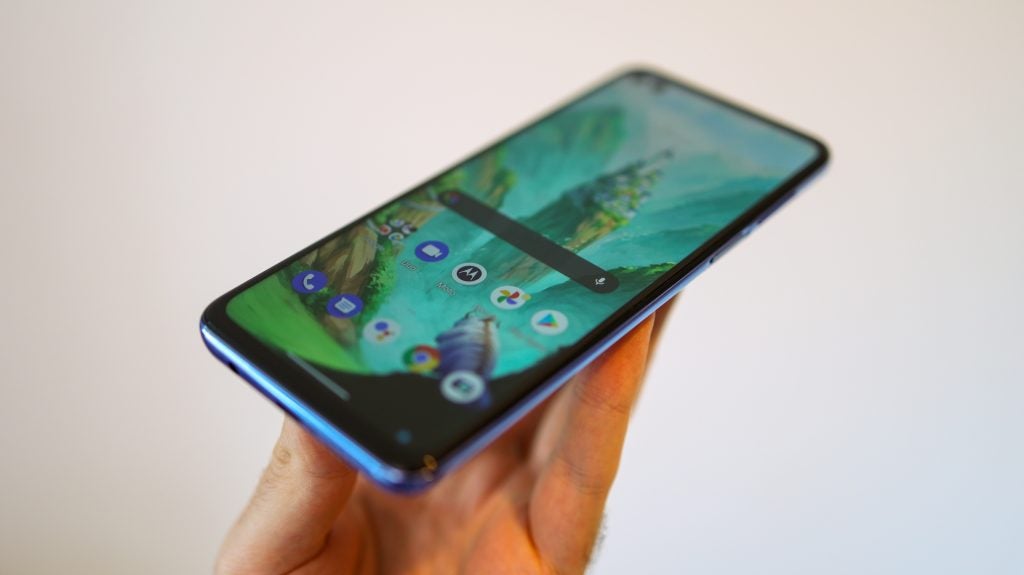
Despite a few wins though, I do wish the Moto G100 was more distinguished. It looks like an overgrown Captain Planet when set against the Batman of Motorola’s line-up: the cheaper, less powerful Motorola Edge, which can be had for £399.99 on Motorola.co.uk. Even the Edge’s screen puts that of the G100 to shame, with its OLED technology and less bezel-heavy frame.
The G100’s 1080 x 2520 IPS panel isn’t bad by any means. Viewing angles are strong, and it scrolls smoothly at up to 90Hz, while packing HDR10 support. At 6.7 inches and with a 21:9 aspect ratio though, it does make for a very tall experience, mid-range experience, and its peak brightness could be a touch higher in direct sunlight. Set alongside the cheaper Poco F3 and Redmi Note 10 Pro, Motorola’s screen falls flat.
Motorola Moto G100 camera – capable, not a lot more
- Mediocre 64MP main sensor
- Impressive 16MP ultra-wide plus macro
- ToF sensor and depth sensor
Motorola has never wowed with its cameras. The brand has always tended to do a decent job in ideal conditions, especially for the price, but never offer best-in-class imaging in challenging scenes.
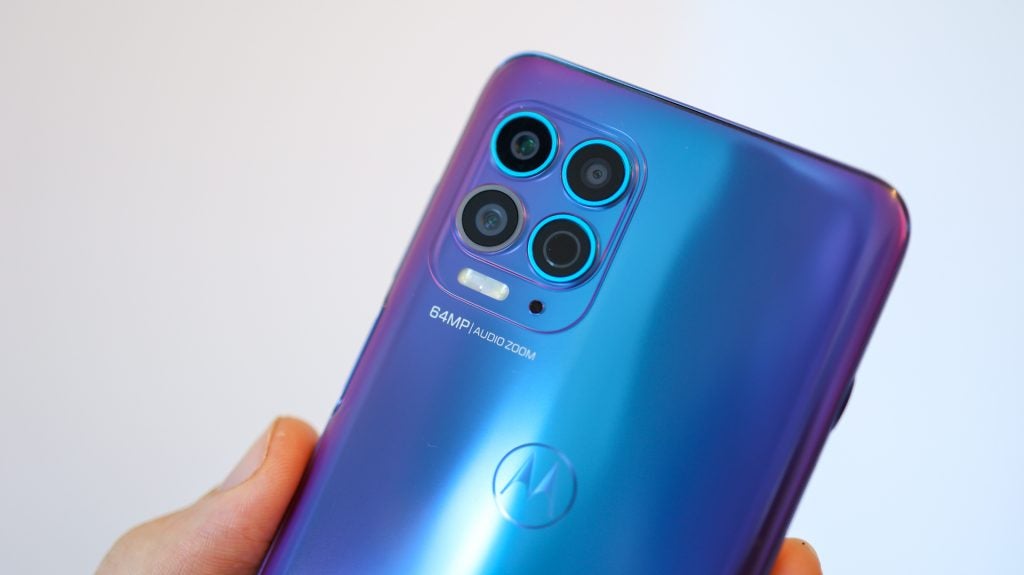
Since the 64MP Samsung ISOCELL sensor was introduced to the Moto Gs, including the recently reviewed Moto G30, this good, not great performance is getting a bit predictable.
The Moto G100 is no exception, but it’s a bit harder to swallow given the phone’s price.
The 64MP camera at the helm excels in well-lit scenes, though crumbles when the lights go down. It’s a real shame it doesn’t sport optical image stabilisation (OIS), which would have helped things along, but even when compared to some cheaper competition lacking OIS, like the Redmi Note 10 Pro, the G100 falls short.
Bright environments that feed the sensor loads of light can produce beautiful photos, and the phone’s HDR mode is really good, grabbing detail from shadows and boosting them nicely.
The contrast is a bit high, and photos are noticeably sharpened, which is really visible when you zoom in on them; but they still look good.


As soon as the lights go down, everything gets much muddier. The slightest movement from your subject or your own hand sends the camera into a bit of a blur-frenzy that even oversharpening can’t save. This is the same across both cameras, and is what really lets the G100 down.


The phone’s ultrawide camera, with its 16MP resolution autofocus and macro capability, is most welcome.
So many ultra-wide and macro cameras lack autofocus, and Motorola’s decision to combine the two and make it fully featured, like the ultra-wide on the Huawei Mate 40 Pro and other premium camera phones, was the right one.
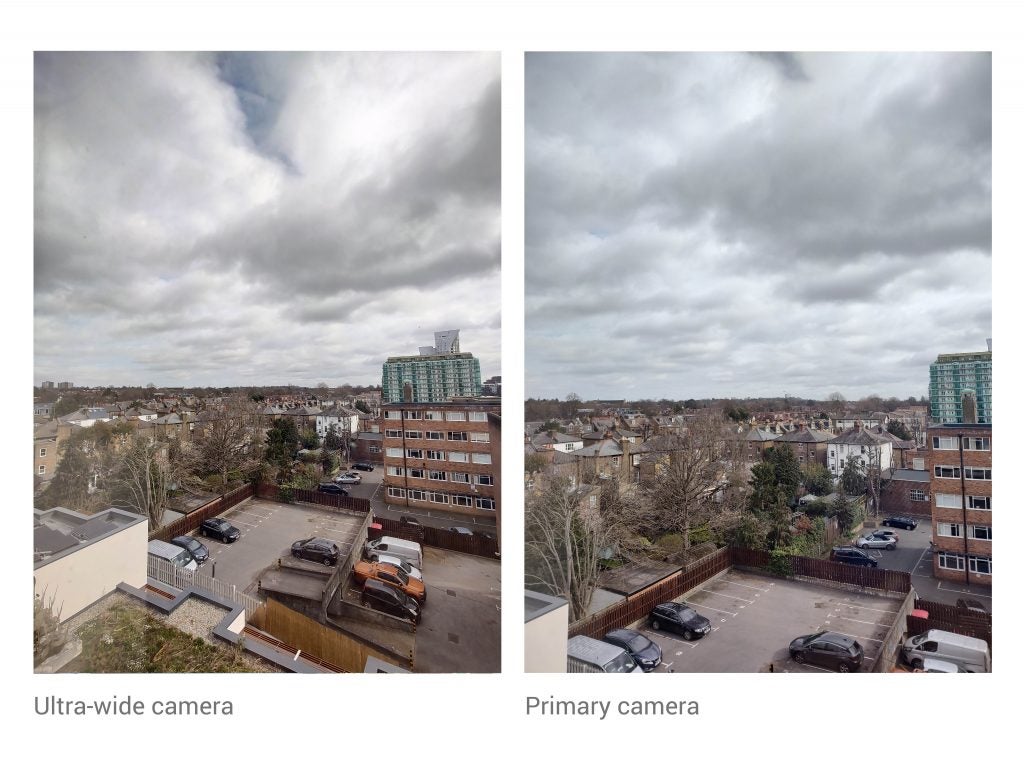
Prop it on a surface and it can take a beautifully detailed macro shot. Once again though, it copes especially badly with dim environments, given the fact when switched to macro-mode, it crops into the ultra-wide frame, thereby magnifying handshake.

The macro isn’t great
So while you can get some fantastic shots from the Motorola G100, it definitely isn’t consistent. The inclusion of a time of flight (ToF) sensor, and a depth sensor is a bit superfluous, though the phone’s portrait mode is respectable, and video capture is competitive too.
The G100 shoots at up to 6K resolution (30fps) with no electronic image stabilisation (EIS), and up to 4K resolution (60fps) with EIS active.
In the dark, it can’t stack up to better cameras like the OnePlus 9 with its video Nightscape mode, for example, but competes with similarly priced smartphones.
As for the dual-selfie-camera, the main 16MP, f/2.2 wide-angle and 8MP ultra-wide miss the mark when it comes to capturing flattering skin tones or stacks of detail. They are also relatively unusable in low light without a fill-flash, though do grab a usable selfie in well-lit scenes.
Motorola Moto G100 performance – Powerful performance plus a novelty dock
- Snapdragon 870 delivers 2020 flagship-grade power
- Clean Android skin
- Big-screen experience — Ready For, debuts on G100
The Motorola G100 is very well specced when it comes to power for the price. This power is all thanks to the Snapdragon 870, a new chipset from Qualcomm that’s a 5G variation of the 2020 Snapdragon 865. Throughout my time with the phone I have found it very quick in day-to-day use, which mirrors the results of the synthetic benchmarks I ran.
Despite undercutting the Pixel 5, it achieves a respectable Geekbench single-core score of 955, and a multi-core score of 2824, not far off double the performance of Google’s pricey camera champ.
The phone also sports 128GB storage, a microSD card slot (or a second-SIM slot) and 8GB RAM, so neither storage nor speed should be an issue for most.
The phone runs Android 11, the latest version of Google’s mobile OS, and Motorola has always kept its take on Android respectfully stock. There are Moto flourishes, some illustrations here and there, as well as additional modes, but the core UI experience is in line with Google’s vision.
With a bottom-firing mono speaker that’s easy enough to cover up, the Moto G100’s audio is a bit disappointing — less pricey Moto G devices have packed dual-speakers — but the G100 is still plenty loud. That said, Moto’s vision doesn’t involve you watching your content on the phone itself.
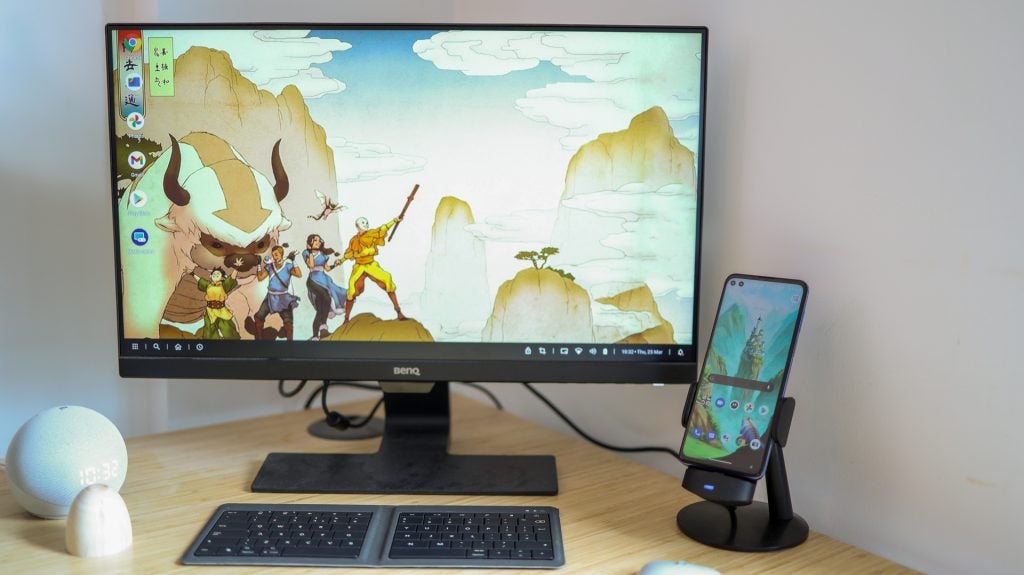
Ready For, Motorola’s projected UI experience refers to the ways you can use the Moto G100 on a big screen, by way of either an HDMI cable or a fiddly magnetic dock the phone ships with. Once assembled, it plugs into a TV and power connector, and when the phone is placed on it, a Ready For menu appears.
Whether you want to game, watch content, video call chums or enjoy a desktop UI, Ready For has your back… sometimes. Each instance of Ready For packs a few pitfalls.
Gaming, for example, requires a controller, which you’ll have to buy separately. Additionally, most Android titles are touch-optimized, and the G100 doesn’t give you an option to map controller keys to on-screen controls, like the Asus ROG Phone 2, for example. Some games work great, but most won’t.
What about streaming platforms? It’s just as hit and miss. BBC iPlayer, Disney Plus, HBO Max and Netflix worked great. Meanwhile, All4, Amazon Prime Video and Sky Go wouldn’t display on a second display.
The desktop UI was useful for things like document editing. I wrote a few hundred words of this review on the G100’s Ready For interface with a keyboard and mouse connected over Bluetooth, and it worked just like Samsung’s DeX. With Samsung’s desktop UI not available on non-flagship devices in the G100’s price-range, that makes for a great and unique value add.
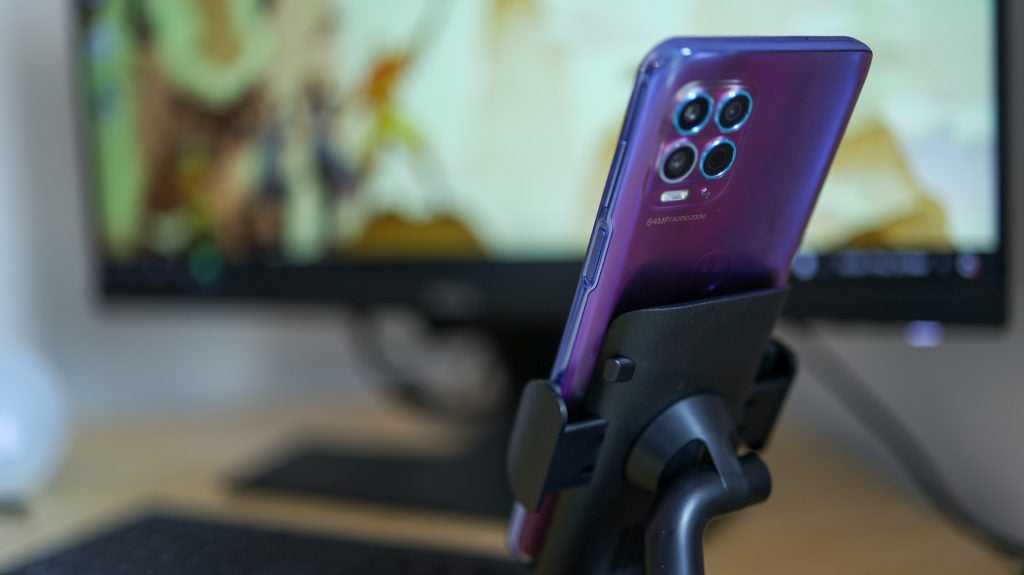
I also found myself using the phone’s unplugged dock around the flat a fair bit, when cooking dinner and watching content or video calling while getting on with something else. When plugged in, it has a fan that keeps your phone cool while powering it up, but even when it isn’t connected, the dock is still useful.
Despite its clunky hardware smacking of Windows Mobile circa 2005, therefore, I can’t argue with the fact the dock adds functionality to the G100 and Motorola isn’t making you fork out an arm and a leg to buy it separately.
Moto G100 battery life – Big phone, big battery
- Hefty cell inside the G100
- Charger included
With most of the best phones today rocking roughly 4500mAh of battery capacity, the 5000mAh cell in the Moto G100 is off to a great start on paper.
It supports Motorola’s 20W Turbo Charging, so 15 minutes powers up the phone up by around 14%, while an hour of charge half fills the tank.
If you want a full charge, you’ll need to keep the phone hooked up for over two hours. Faster than an iPhone, slower than most other similarly-priced smartphones.
I easily made it through a full day with the G100 using it casually, with a 30-minute episode streaming over Wi-Fi dropping the battery by about 8%.
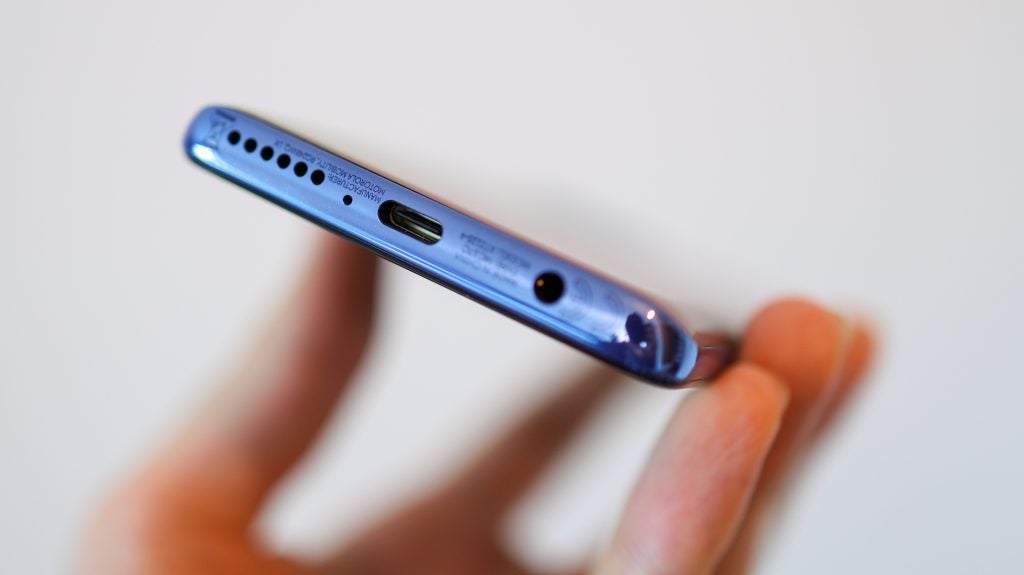
There’s a headphone jack…
The screen-on time isn’t as impressive as expected, when compared to other smartphones with OLED screens and smaller cells, however, thanks to the sheer capacity of the G100’s battery, it should still last most a day without fail.
Motorola G100 Conclusion
You can’t argue with the value Motorola offers: the phone packs power and accessories at a reasonable price. Some risks have paid off, with the dock being a useful addition, albeit a clunky one.
Add to the mix smooth performance when gaming and using the G100 throughout the day, and it was a pleasure to swipe and tap away on.
That said, with its hit and miss camera and an immature, chunky design it has fallen a bit flat.
The result is a very niche device that definitely offers value in spades but lacks the refinement of the best mid-range phones from brands like Samsung in the less powerful, much prettier Samsung Galaxy A52 5G, and Xiaomi’s Redmi Note 10 Pro.
You should buy the Moto G100 if:
- You’re a giant geek who loves fiddling with accessories
There’s an undeniable geek-factor to the Moto G100’s dock, and when it works, it works really well, opening up working across windows, and enjoying big-screen video and gaming with just your phone and an external display.
- You want maximum power for the price and stock(ish) Android
If you want a 2021 smartphone for gaming, the G100 is a decent option, with ample power to playback Genshin impact on max settings. It’s also one of a handful of powerhouses with a relatively stock Android 11 interface.
You shouldn’t buy the Moto G100 if:
- You crave an end-to-end refined experience
The magnetic dock is a bit clumsy and the phone’s clunky holographic styling feels like a prop from an 80s fantasy flick. If you want more refined and modern, opt for the Samsung Galaxy A52 5G, or even an iPhone SE 2020.
- You have small hands
A 21:9 aspect plus a 6.7-inch screen size makes for a massive phone. Add thickness to the mix, and the plastic fantastic Moto G100 misses the mark for anyone with dinky digits.
Specifications
How we test phones
We test every mobile phone we review thoroughly. We use industry standard tests to compare features properly and we use the phone as our main device over the review period. We’ll always tell you what we find and we never, ever, accept money to review a product.


